MIKE SLATON, Contributing Editor
 |
| A pumpjack and wind turbine co-exist in the Permian basin of Texas (photo courtesy of Hendershot Photography, Midland, Texas); a wellhead frac rig-up underway in the Permian (photo courtesy of Hendershot Photography); and a rig and fence post highlight the desolate topography of Loving County, Texas, in the Permian, the least-populated county in the U.S. (photo by Mike Slaton). |
|
The bumper sticker reads “Carpe oleum” (seize the oil), and it is westbound on Texas 302, heading for Kermit. The sticker, and the truck it is attached to, are quickly lost in the hodgepodge of pickups, logging units, water haulers, welders and other oil patch traffic that constitutes the morning rush hour, in what is typically one of the least populated parts of Texas. Lost, but not forgotten, the westbound witticism reflects the intensity of mood and activity across the country, and, with particular fervor, in two venerable basins—the Permian and the Anadarko.
Liquids, long laterals, and lots of high-pressure, multi-stage pumping continue to drive Permian and Anadarko basin activity, as operators steadily shift their portfolios away from low-price gas assets. The focus is on oil and condensates in new intervals, and at greater depths in a mix of shale, sandstone and carbonate plays. Using technology and methods first advanced in unconventional shale development, operators are aggressively pursuing higher-value liquids in assets like the Permian’s Spraberry and the Anadarko’s Mississippian. In these plays, efficiency is king, as operators emphasize performance improvements through such efforts as pad drilling, optimized drilling and fracturing processes, and infrastructure.
PERMIAN BASIN
Permian basin activity continues at a remarkable pace. Drilling permits reached 9,630 in 2012, a considerable climb from the 2009 low of 3,323, Fig. 1. Through June of 2013, permits had already passed the 2012 halfway point with 4,984 permits issued, reports the Railroad Commission (RRC) of Texas. The rig count in 2009 was 103; last year, 415 rotaries were working. In mid-August 2013, Baker Hughes counted 470 active rigs.
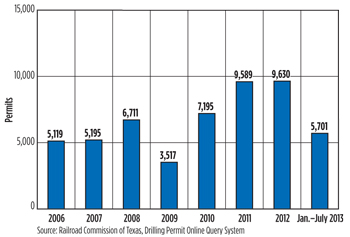 |
| Fig. 1. Permian basin drilling permits have risen in every year since 2009. |
|
Production statistics show the decisive shift to liquids, Fig. 2. Since 2009, crude production has grown from 712,454 BPD to 901,119 BPD in 2012. At midyear 2013, daily crude production was already at 886,115 bbl.
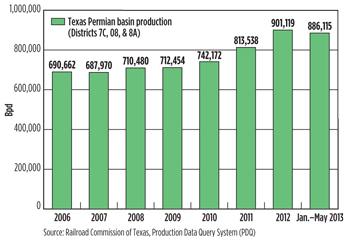 |
| Fig. 2. Permian basin oil production has grown significantly in recent years. |
|
Total crude production, which had lingered around 255 million bbl between 2005 and 2009, hit 312 million bbl last year. The 2012 total accounts for 57% of Texas crude production. In total liquids production, the basin is 51% of the state total. Annual state oil production is about 25% of total U.S. output. Gas production, on the other hand, has declined and flattened. In 2009, the Permian basin produced 3.552 Bcfgd. In 2011 and 2012, it hovered around 3.000 Bcfgd, and at mid-year 2013, it was at 2.932 Bcfgd.
The Permian basin is geologically more complex than typically described, especially when compared to plays like the Eagle Ford. Spread across 86,000 sq mi (Fig. 3), it comprises several sub-basins with multiple zones and distinctive characteristics, including the Midland, Central, Delaware, Northwest Shelf, and Tatum.
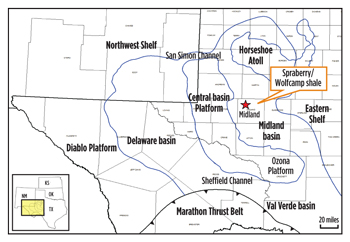 |
| Fig. 3. The Permian basin is comprised of a number of sub-basins covering about 86,000 sq mi (map courtesy of Pioneer Natural Resources). |
|
Activity is spread across these geologic provinces and formation intervals, with oil and natural gas production ranging from depths of a few hundred feet to five miles. The Midland basin’s Spraberry trend, in all its multi-interval iterations, continues to be at the epicenter of Permian activity, particularly in the deeper rock. As a further sign of the times, it’s worth noting that the lively Spraberry was discovered in 1943.
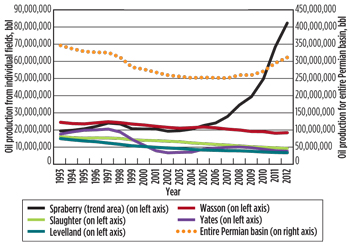 |
| Fig. 4. The 20-year production histories of the top five fields in the Permian basin present a mixed picture. |
|
In order of rank, the highest-producing fields (Fig. 4) in the basin are Spraberry, Wasson, Slaughter, Yates, Levelland, Kelly-Snyder, Seminole, McElroy, Salt Creek, Crowden and North. In Spraberry, production that was 20 million bbl per year a decade ago is 80 million bbl today. The other top producers all have production below 20 million bbl per year, and have been relatively flat or have experienced a production decline.
In New Mexico, where the Permian basin includes Lea, Eddy, Chaves and Roosevelt Counties, oil production is also increasing, while gas is decreasing. The southeastern corner of the state produced 237 million bbl in 2011, and 282 million bbl in 2012, according to the New Mexico Oil Conservation Division. Production in first-half 2013 was 131 million bbl. Conversely, gas production was 173.929 Bcf in 2011 and fell to 150.831 Bcf in 2012. It declined to only 56.159 Bcf in first-half 2013.
PERMIAN OPERATOR ACTIVITY
A mixture of majors, and large and medium independents, is exploiting the Permian basin on a scale not seen before. What follows are several examples.
Pioneer Natural Resources. The third-largest producer in Texas, Pioneer has operated in the Permian’s Spraberry/Wolfcamp area since the early 1980s, and has about 900,000 acres in the play. During 2013, it is operating 12 horizontal and 15 vertical rigs, and producing 7,000 wells.
Of its $2.75-billion, liquids-focused, capital drilling budget, $1.225 billion is dedicated to the northern Spraberry/Wolfcamp play. That includes $400 million in the horizontal program, $625 million for the vertical program, and $200 million for infrastructure and automation.
The northern horizontal drilling program had a successful first quarter, says Pioneer. Strong performance from the firm’s first Wolfcamp B interval well in Martin County further confirms the Wolfcamp B potential, after successes in Midland and Upton Counties to the north. The first Midland County well was producing at more than 400 boed after 180 days.
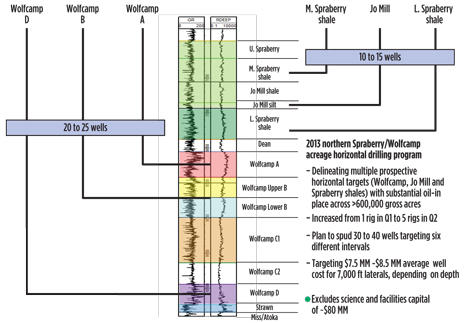 |
| Fig. 5. Multiple intervals over a wide range of depths characterize Pioneer’s horizontal drilling in its northern Spraberry/Wolfcamp acreage (image courtesy of Pioneer Natural Resources). |
|
The operator is delineating multiple horizontal targets in its northern Spraberry/Wolfcamp acreage, Fig. 5. Drilling plans this year call for 20 to 25 wells in the Wolfcamp A, B and D intervals (between about 8,000 and 10,000 ft), and 10 to 15 wells in the Middle Spraberry shale, Jo Mill, and Lower Spraberry shale formations (roughly 7,000 to 8,000 ft).
One rig was working in the first quarter, and four more have been added in the second quarter. Pioneer expects to ramp up to eight rigs in 2014. The five-rig program is using two-well pads for better efficiency. In each case, the wells will be completed after the second well is drilled. Drilling time is 120 to 150 days. Average cost for the 7,000-ft lateral wells is $4.5 million to $8.5 million, each. In the second half of the year, production will be added from 20 new wells.
In its southern Wolfcamp JV drilling program, Pioneer placed 22 Wolfcamp B interval wells on production in the second quarter and pumped 18 slickwater fracs.
|
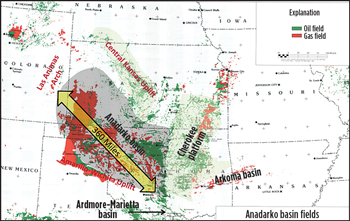
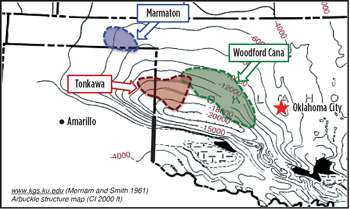
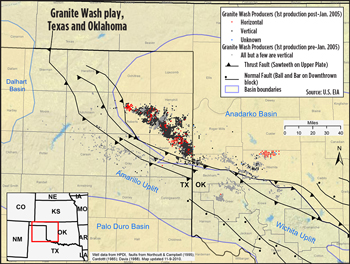
|
| Fig. 6. Decades of vertical history are on the verge of a rewrite, as operators apply horizontal methods across the Anadarko basin (top), including the Woodford Cana (center) and Granite Wash (bottom) plays. |
|
With seven rigs running, they expect to add three more in 2014, and another three in 2015, for a total fleet of 13 rigs. Pioneer says the equipment will drill 86 wells in 2013, and 120 in 2014. The January sale of a 40% interest in the area to Sinochem Group will help accelerate development.
The 2013 drilling program is testing multiple Wolfcamp intervals. For 8,300-ft laterals, well development costs are budgeted between $7.5 million and $8 million, each. Pioneer expects to drill roughly twenty 10,000-ft lateral wells in 2013. About 70% of the drilling will be from three-well pads. Horizontal production is expected to increase from an average 2,000 boed in 2012 to between 11,000 and 14,000 boed this year.
The 2013 Spraberry/WolfCamp drilling program also includes 15 vertical rigs, which drilled 73 vertical wells in the second quarter. Three hundred wells are planned, with about 90% drilling to the deeper Strawn and Atoka intervals.
Occidental Permian Ltd. Oxy has its largest U.S. operations in the Permian basin, where it is the leading oil producer. The company operates more active carbon dioxide (CO2) floods than any other operator. Approximately two-thirds of its Permian oil production is from fields that actively employ CO2 flooding.
However, says Oxy, non-CO2 operations are some of its fastest-growing assets, and they are focused on growing U.S. oil production. Over a third of Oxy’s Permian production is primary. Since beginning significant delineation and development efforts in 2010, production has increased more than 25%. The company’s 2.5 million net acres in the Permian include new plays, such as the Avalon shale, Bone Spring, Wolfbone/Wolfcamp, Cline shale, Wolfberry and Delaware. More than 300 non-CO2 wells were drilled in these plays during 2012.
Globally, Oxy’s objective is to grow oil and gas production by 5% to 8% per year. Domestic oil and gas is about 61% of total production, and oil is 61% of that mix. Oxy’s U.S. oil production, during 2013, is expected in grow 8% to 10% over the 2012 increase of 6%.
At the same time, Oxy is reducing overall 2013 capital spending by approximately 6%. The Permian capital budget has not changed much in this reduction, and drilling activity should be similar to last year, says the company. But their overall rig count will decline about 14%, from 64 rigs in 2012 to 55 rigs in 2013, due to the elimination of less productive drilling units.
Reductions in operating costs and improvements in drilling efficiency are expected to lower 2013 production costs, per bbl, to under $14. In addition, Oxy expects to reduce 2013 drilling costs in the U.S. by 15%.
Efficiency improvement efforts also include locking in drilling programs, modifying well objectives and design, and improving operational execution and contracting strategies. Oxy reports a 19% reduction in domestic well costs in the first half of 2013 versus 2012.
In the Wolfberry, costs have dropped by 20%, and rig downtime has been cut by 20%, says Oxy. Using two casing strings, instead of three, in the firm’s Wolfberry program has saved approximately $250,000 per well. Stimulation costs have also been reduced by 47% per frac stage.
Apache Corporation. Apache has accelerated its North American onshore drilling in 2013, with 1,000 gross wells planned. The objective is to increase liquids growth by about 25%. Its Permian basin liquids production is expected to grow this year, to about 94,000 bpd, up from 38,000 bpd in 2009.
The company has gross Permian acreage of 3.5 million acres, and net acres total 1.6 million, with net resources of 3.08 billion boe. In 2012, Apache drilled 781 wells, including 104 horizontal holes. For 2013, they plan to keep 34 rigs working to drill approximately 180 horizontal wells out of a total of 700. Through the second quarter, the company employed 41 rigs, with 17 dedicated to horizontal drilling.
Its horizontal oil targets are in the Wolfcamp and Cline shales. Vertical drilling in the Midland basin targets the Wolfwood and Fusselman plays, with 40-acre vertical locations and 20-acre infill locations.
In Wolfcamp shale drilling, Apache’s horizontal momentum is building. During 2012, 21 horizontal wells were drilled; more than 90 are planned this year. Apache points to three wells as examples of its Wolfcamp success. The Bennie #2H, a 9,300-ft lateral fractured in 30 stages, had a peak IP of 1,260 boed, and a 30-day average of 799 boed; the Sugg #7H, a 7,567-ft lateral with 27 frac stages, had a peak initial production of 1,225 boed, and a 30-day average of 696 boed. Finally, the Bennie 4342M-9H, a 9,094-ft lateral with 33 stages, had a peak IP of 1,184 boed, and a 30-day average of 792 boed.
In the Cline shale, Apache is expanding its horizontal program from six wells drilled in 2012 to more than 30 wells in 2013. The focus is on Glasscock County, where the firm had four rigs running. Successes include the Barracuda 45 #2H, a 3,780-ft lateral with 11 frac stages that had peak IP of 623 boed, and a 30-day average of 623 boed; the Mack 6-Carter 43, a 6,705-ft lateral stimulated in 12 stages for peak IP of 379 boed and 30-day average of 320 boed; and the Marlin 47 2H, a 4,255-ft lateral with initial IP of 392 boed and 30-day average production of 341 boed.
A key objective in these resource plays is to drive down costs, says Apache. Steps toward reducing drilling and completion expenses include cutting drilling days through pad drilling, and optimization of bits and mud. Reductions in hydraulic fracturing costs are being sought through self-sourcing, optimizing frac designs, and synergies from pad drilling and frac ponds. In the Wolfcamp and Cline shales, the efforts have yielded a per-well drilling and completion cost reduction of more than $1 million, notes the company.
ANADARKO BASIN
Is the Anadarko basin poised for its own boom? The activity of many operators and states suggests that it is already in gear and moving fast, as operators begin to apply long laterals and multi-zone hydraulic fracturing methods across the province.
The basin is spread across 50,000 sq mi in western Oklahoma, the eastern Texas Panhandle, western Kansas, and the tip of southeastern Colorado. The U.S. Geological Survey counts 25 plays in the province. Much of the current oil focus is centered on three horizontal plays—the Granite Wash, Cana Woodford, and the Mississippian.
The Mississippi Lime in northern Oklahoma and southern Kansas is a massive carbonate beneath the productive Atoka and Morrow sands, and it overlays the region’s primary source rock, the Woodford shale. Recent horizontal success follows decades of modestly productive vertical drilling. The horizontal wells have generally been inexpensive to drill and complete. With vertical depths from 3,000 to 6,000 ft, a horizontal well may cost $3 million to drill and complete. But the Lime is characterized by multiple conventional and unconventional reservoirs, and will present its own challenges, from varied pay quality to produced water.
The Granite Wash in western Oklahoma and the Texas Panhandle is a tight sand (or conglomerate) with low permeability and porosity. Horizontal wells have shown some impressive production, but the alluvial geology is complex, and understanding the play will take some effort.
The liquids-rich Cana Woodford shale in western Oklahoma is a deep, non-conventional horizontal play, with vertical depths approaching 15,000 ft.
ANADARKO OPERATOR ACTIVITY
As operators focus on liquids development, activity continues to grow in the basin. The resulting growth in production is impressive.
Apache Corporation. Horizontal drilling success is driving Apache’s liquids-centered activity in the region, Fig. 7. It has 1.9 million gross acres, translating to 1 million net acres, in the western Anadarko basin and the Canyon Wash in the western Texas Panhandle.
 |
| Fig. 7. Apache is very active in the Anadarko basin, averaging 28 rigs during the second quarter of 2013, and drilling 87 gross wells (photo courtesy of Apache Corp.) |
|
During 2012, Apache drilled 184 horizontal wells out of a total well count of 192. Targets included the liquids-rich Granite Wash, and the oily Tonkawa, Marmaton, Cottage Grove, Cleveland and Canyon Wash plays. Liquids production in fourth-quarter 2012 was 24% ahead of the prior year.
Apache has a $1.4-billion exploration and development budget this year. The company plans to dedicate 28 of 29 rigs to drilling horizontal holes, and drill 285 horizontal wells among a 300-well total. Cost reduction efforts are an ongoing process. Apache says it has reduced Granite Wash drilling and completion costs by $1.3 million to $2 million, and by $1.5 million in the Tonkawa.
Devon Energy. Devon plans to employ 10 rigs and drill approximately 150 wells in the Cana-Woodford, Granite Wash and Mississippi Lime. The largest leaseholder in the Cana-Woodford (Fig. 8), Devon has 250,000 net acres in Oklahoma’s Canadian, Blaine, Caddo and Dewey counties. It reported net production of 322 MMcfed in the second quarter of this year, with oil and NGLs accounting for about 40% of total production. That’s up 48% from last year.
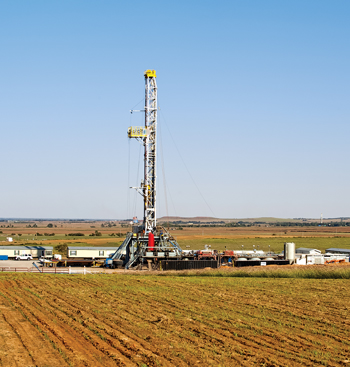 |
| Fig. 8. Devon overcame considerable technical challenges while exploring the Cana-Woodford shale of west-central Oklahoma. Today, the play is a cornerstone asset for Devon (photo courtesy of Devon Energy). |
|
In the Mississippian oil play, Devon increased it holdings in 2012, and now has about 600,000 net acres. Early evaluation of the play has been encouraging, and Devon has ramped up drilling for an active 2013 program. Optimization of the play is being pursued through 3D seismic, core samples, logs and production data for comprehensive reservoir modeling.
Granite Wash acreage is focused on liquids and natural gas production from the play’s conventional reservoirs. Devon says high initial production rates, and strong liquid yields, are key drivers. In 2013, it plans to drill about 50 wells.
Chesapeake Energy. Amid asset sales and senior management changes, Chesapeake continued its shift to liquids. During 2012, liquids production increased 54% over 2011, and constituted approximately 85% of the drilling and completion budget. The company says efficiency gains from pad drilling have reduced costs between 15% and 30%.
The greater Anadarko basin is allocated a 30% share of Chesapeake’s drilling and completion budget, second only to the 36% spent in the Eagle Ford shale. In the basin, Chesapeake interests include the Granite Wash and Mississippian plays
Chesapeake is the largest leaseholder in the Mississippi Lime, with approximately 2 million net acres. The firm cites 4,500-to-5,000-ft laterals, and multi-stage hydraulic fracturing, as keys to development.
SandRidge Energy. SandRidge’s activity in the Mississippian play had 25 rigs running at mid-year, and the firm posted a first-quarter, year-to-year production jump of 104%. Development focuses on 2.8 million acres across six counties—Comanche, Barber and Harper in Kansas; and Woods, Alfalfa and Grant in Oklahoma.
SandRidge plans to drill 425 wells this year, compared to 396 in 2012, 167 in 2011 and 37 in 2010. It is the most active operator in the play, and says it has drilled nearly half of the wells, to date. Its 2013 development plans include tests across several counties that will drill 40 Middle Mississippian wells, four Lower Mississippian wells and two Chester wells.
The Mississippi Lime play offers exceptional economics because of its low-cost, shallow carbonate formations that require less horsepower to drill, and lower-pressure pumping equipment for completions, says Sandridge, Fig. 9. Stacked pay creates significant multi-zone potential that increases resource potential and improves recovery rates. The company also owns 31 drilling rigs, which reduces its costs.
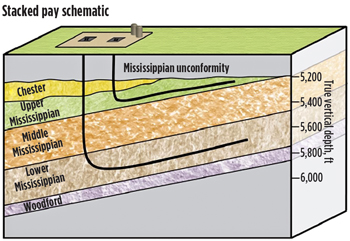 |
| Fig. 9. Stacked pay and horizontal drilling are key to SandRidge’s development in the Mississippian play (photo courtesy of SandRidge Energy). |
|
SandRidge says pad well drilling, using dual- and quad-pad locations, is achieving wellsite efficiencies and cost-savings. Other cost-saving initiatives are aimed at improving completion designs with cemented liner, plug-and-perf completions, and openhole packers with sleeves. Rotary steerable drilling is being used to improve performance, along with single-sleeve casing designs.
QEP Resources Inc. QEP has about 17% of its development budget aimed at the Granite Wash, Tonkawa, Marmaton and Woodford-Cana fields. The firm’s shift to liquids in 2010 has resulted in liquids growing from 14% of net production to 30% between 2011 and the middle of this year.
QEP’s Woodford Cana development is focused on the liquids part of the play. One rig was drilling in June, and the company anticipated 12 new well completions in the first half of 2013, at an average cost of $8 million per well. The horizontal wells average about 13,000 ft, TVD, and 18,000 ft, MD.
NEW PAY IN OLD PROVINCES
Multiple-target intervals, long laterals and multi-stage fracs are the fuel behind new efforts to develop old plays. With liquids as the objective, operators are actively pursuing untried zones and new depths in the Permian and Anadarko basins. At current and planned activity levels, liquids production will grow considerably. 
|














